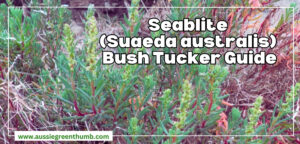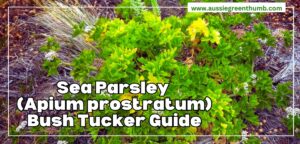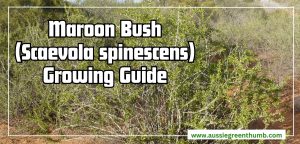Eucalyptus gunnii is one of the most iconic landscape trees in the world. Horizon-breaking silver bark, paired with sparkling chrome green clouds of bristling foliage offer something to gardens and parks that no other tree can match.
Whether you grow it as an elegant standard with a single stem, or allow it to take a more natural form with the open limbs of its multi-stemmed form, Eucalyptus gunnii will bring a vibrant, sparkling, touch of nature to your garden.
In this guide, we’ll share how to grow Eucalyptus gunnii, and how to prune in the early stages for a better form later on.
More...

Family: | Myrtaceae |
|---|---|
Genus: | Eucalyptus |
Species: | E. gunnii |
Origin: | Tasmania |
Common Names: | Cider gum |
Location: | Outdoor |
Type: | Tree |
Growth: | 35m tall |
Sun requirements: | Full sun or part shade |
Foliage Colour: | Silver-green |
Flower Colour: | White |
Flowering: | Summer |
Edible Parts: | None |
Maintenance level: | Low |
Poisonous for pets: | Toxic to cats and dogs |
What is Eucalyptus gunnii?
Reaching a mature height of 35m, with a distinctive swollen base to its trunk (lignotuber) the fragrant tree, also known as the Cider Gum, produces a sweet sap, which has been historically used for brewing traditional alcohols.
The leaves of Eucalyptus gunnii are elongated, with a pointed tip, displaying vibrant blue-green colouring and a chromatic hue. One cultivar of E. gunnii (E. gunnii ‘Azura’) is a dwarf form that will reach about 20m at maturity, and has more recognisable rounded eucalyptus leaves.
Cider Gum’s Natural Habitat
Eucalyptus gunnii is a large tree in the Myrtle family (Myrtaceae) native to Tasmania but fairly well naturalised throughout the rest of Australia. This cold hardy eucalyptus loves full sun, good drainage, and rich soil, so is simple to establish in most gardens.
Different Types of Eucalyptus gunnii
There are five accepted cultivars (and many on the market that are wrongly labelled from other species), including the basic species tree E. gunnii, one accepted subspecies (E. gunnii subsp. divaricata), and three identifiable names cultivars (Azura, Silerana, and France Bleu).
They are all bred to make the most of the cold hardiness of these Tasmanian natives, and mostly share the same bark and leaf colours with variations in height and leaf shape.
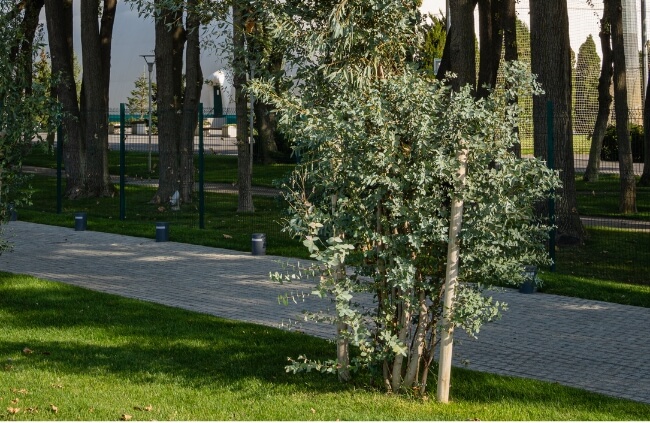
Eucalyptus (Cider Gum)
The common cider gum tree, Eucalyptus gunnii, is the species in its true form, with elongated foliage held on stunning yellow stems that hold their colour from spring until autumn, when they develop to form firmer, silvery colouring.
They are wonderfully easy to grow, regardless of how you prune them, and are highly pest resistant trees for any size of garden provided they are pruned or coppice to fit their space.
Eucalyptus ‘Azura’ (Dwarf Cider Gum)
Azura, the dwarf cider gum, is the most commonly sold cultivar of Eucalyptus gunnii. The foliage on young or coppiced trees tends to be more rounded, but as the tree matures it develops into slightly pointed forms – though not as noticeable as its natural cousin.
Stems tend to be slightly red or pink too, which softens their overall effect especially on coppice plants. They are a dwarf variety, but will still grow up to 20m tall without pruning or container restriction.
Eucalyptus ‘Silverana’ (Silver Cider Gum)
The silver cider gum, Eucalyptus ‘Silverana’ is a full-sized cultivar, so will need coppicing, or managing as a pruning multi-stem tree in most gardens, but it’s stunning bi-lobed leaves, with slight pointing, and much more notably silver-blue tone, which fade to nearly completely white in winter, are just gorgeous.
If you’re looking for a hardy eucalyptus that would work as a hedge, or for screening around a pool, this is definitely a good choice.


Get Your Free Guide:
Master Growing Australian Natives eBook
A Must Have Complete Guide for Every Australian Garden
Get Your Free Guide:
Master Growing Australian Natives eBook
A Must Have Complete Guide for Every Australian Garden
Eucalyptus ‘France Bleu’
Eucalyptus ‘France Bleu’ has incredibly narrow leaves, offering a much finer canopy that allows spectacularly dappled light to fall through, whether it’s growth in containers, or coppiced.
It will grow to about 15m tall in most conditions, but can reach over 20m if left to grow as a standard.
In winter, its foliage thickens and lasts for months as cut stems in vases.
Eucalyptus gunnii subsp. divaricata (Miena Cider Gum)
Also called Blue Ice Cider Gum, the Miena Cider Gum is a naturally occurring subspecies of Eucalyptus gunnii.
Early leaves in spring push out old darker leaves that the trees hold onto through winter, but they fade to a deeper shade of green as the year goes on, offering plenty of seasonal shifts that help to ground you and your garden as the year passes.
Check out our roundup of different types of eucalyptus and see which could best fit your garden.
Uses for Eucalyptus gunnii
Eucalyptus, in any form, is a useful plant. It wards off pests, and offers opportunities for creating your own botanical medicines. For centuries, eucalyptus has been used to open swollen or sore throats, and aid breathing, but its oils and sap can also help to cool burns and relieve itching.
Is Eucalyptus gunnii Edible?
Eucalyptus is harmful if consumed orally, and contains variation chemical compounds that can interact badly with other medicines. However, the Cider Gum tree has historically been used to brew fermented alcoholic drinks by aboriginal communities thanks to its natural yeast and sugar content.
The cider it creates is sweet, and highly perfumed, though there is not enough evidence to suggest whether or not it is actually safe to consume – especially due to potential interactions with prescribed medication.
Eucalyptus gunnii Medicinal Uses
Making your own essential oils is actually pretty simple, and there are a few different ways to do it. The easiest is the slow method:
Harvest eucalyptus leaves, and lightly crush them, then place them tightly in a glass jar, before covering with a flavourless carrier oil (almond oil works well).
Leave it in a sunny spot for up to a month before straining the oil into an air tight bottle. The highly scented oil will last for years if stored properly.

Easier still, for quick relief from colds, coughs and hay fever, hang freshly cut eucalyptus branches from your showerhead, and take a hot shower. The running hot water will release oils as you shower, and create a fragrant mist (plus the bonus perfume you’ll get for yourself).
Household & Garden Uses for Eucalyptus gunnii
Some other benefits of growing Eucalyptus gunnii, thanks to its highly scented foliage, and sap production, are that it can be used as a spider deterrent for around the house, and the plant, if coppiced to form a low growing shrub, will deter pests from hanging around, making it an ideal patio screen.
How to Grow Eucalyptus gunnii
Eucalyptus gunnii might be a large tree, but it responds well to coppicing, and tends to put on 1-2m of new growth each year, so even if you’re planning on something a little more subtle than a full sized tree, we’ve got step-by-step guides on caring for E. gunnii at home that will keep your garden looking loved.

Source: Seeds And Smiles
Ideal Conditions for Planting Eucalyptus gunnii
Regardless of how you grow Eucalyptus gunnii, you’ll need to check that your soil is suitable first. In terms of the right spot, that’s not too much of a bother, as Cider Gums are cold, wind, rain, and drought tolerant trees that will cope provided they have proper drainage, and reasonable anchorage in the soil.
Soil & Drainage
This plant don’t seem to mind differences in soil pH, so slightly acidic, or slightly alkaline soils are fine. The important bit is drainage. While they do benefit from irrigation or good summer rainfall, they don’t like to be sat in wet soil.
If your garden has heavy clay subsoil, you’ll need to dig down quite deep to prepare the ground, and mix in plenty of grit. Cider Gums also love organic compost.
It can be manure based compost, or garden compost, but mixing it through your soil at the time of planting will really help the roots to establish. Avoid peat-based composts as they tend to hold more moisture than is necessary.
Light & Temperature
Ideally, cider gums like a bright, sunny spot, but they do cope in light shade if grown as coppiced shrubs. They are drought and heat tolerant, as well as frost tolerant, so provided they have some shelter or staking while they’re young, they can be grown in virtually all conditions.
Growing Eucalyptus gunnii as a Standard
The simplest way to plant E. gunnii is as a standard (a single-stemmed tree). Many nurseries will provide them as standards simply because it’s the lowest maintenance option for them as growers, and they can be planted directly into the ground this way, to develop a fast growing tall tree for any space.
Worth noting, if you are planning on growing a full size eucalyptus tree, in any form, they are fast growing, and vigorously rooted, so plant it at least 20m from your house, and away from planting borders that require moisture as it will draw most of the moisture from the rest of the garden.
Growing Eucalyptus gunnii as a Multi-Stemmed Tree
When grown as a multi-stemmed tree, E. gunnii is just as vigorous, and each trunk can grow quite rapidly, but the overall height, regardless of species, will be reduced by about a third.
The main benefit of this is form, offering more privacy and screening, but also denser habitats nesting birds. You can turn single-stemmed Cider Gums into multi-stemmed trees by coppicing the tree completely in late winter to trigger new growth from the base.
Coppicing Eucalyptus gunnii
Coppicing Cider Gum is growing in popularity again, not just because it looks exceptional, and offers an alternative to traditional hedging, but also because it allows gardeners to make use of the fragrant medicinal branches.
Coppicing, cutting multi-stemmed trees back to the ground each year, is a simple task, and can even be done with alternate branches to maintain a year-round hedge.
Plant Eucalyptus gunnii about 1m apart in a slightly staggered row. Leave them to develop for the first 2-3 years without cutting, and then cut out every other branch on an annual basis in late winter. This provides year-round shade, and will keep your cider gum to a height of around 1.5-2m tall.
How to Grow Eucalyptus gunnii in Pots
Even though cider gums are vigorous trees, they do cope well in containers, and will quite happily remain restricted in that same pot for years. Plant into a well-drained potting mix, with plenty of organic matter to hold just enough moisture that watering doesn’t become a daily task in summer.
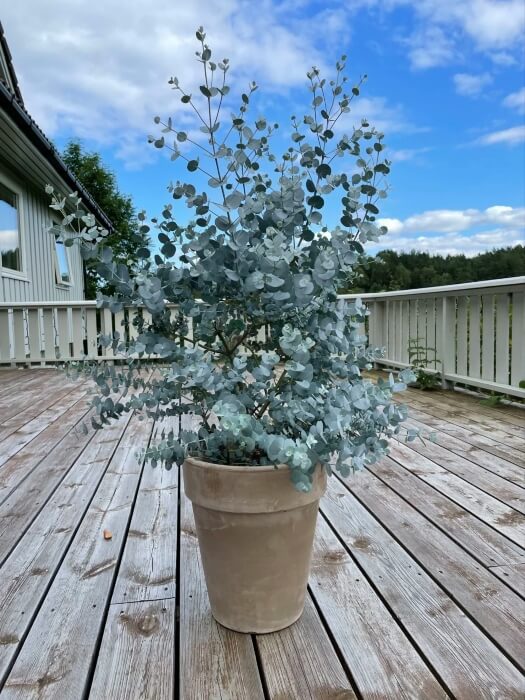
Source: Planta
I use about 40% compost, 20% grit, and 40% sieved garden loam, with a layer of crocks on the bottom of the pot. The tree may rot out of the base of the container, but by pruning roots and coppicing every other year it will quite happily stay restricted as an ornamental shrub for years.
Propagating Eucalyptus gunnii
This plant grows well from cuttings, but with a 50/50 chance of success as the stems are quite quick to dry out (often even drying out when placed in a vase of water). Cider gum is quick to grow from seed, and has reliable germination rates.
Growing from seed is also a great way to learn about basic climate science, and the importance of seasonal change, as they require a period of cold to germinate successfully.
How to Propagate Cider Gum from Seeds
To grow Eucalyptus gunnii from seed, you’ll need a container filled with fairly dry compost. If your garden naturally experiences cold winters (below 5°C) then the whole process can happen outdoors.
If not, pop the seed in an airtight container in the fridge for 1-2 months before planting.
How to propagate Eucalyptus gunnii seeds:
- Allow cider gum seeds to experience a cold winter, either by storing them in the fridge, or outdoors, below 5°C for 1-2 months.
- Then sow directly onto the surface of misted compost, and leave it somewhere warm and bright.
- Germination should be visible in 2-3 weeks.
- After germination, mist the surface of the compost regularly to stop it drying out.
- Once true leaves have formed a couple of weeks later, carefully transplant your seedling into a 15cm pot.
Eucalyptus gunnii Propagation from Cuttings
Cuttings are a little bit hit and miss, but they can work if you move quickly, and get everything set up before removing your cutting material from the plant.
The key is preparation here, so before you get your scissors out, prepare a tray of materials, with pre-filled pots (half perlite, and sandy compost) and liquid rooting gel on hand to dip the ends of your cuttings.
To take cider gum cuttings:
- Fill tall plastic pots with a cutting mix consisting of perlite and sandy compost.
- Cut 20cm lengths of young, green growth from your cider gum, making sure the cut is just above a leaf junction (this is for the appearance of the tree after pruning, but it also stops the true cut callousing).
- Strip off the bottom two thirds of leaves from the stem.
- Make a new cut at the bottom of the cutting, using a clean knife, directly below a node.
- Immediately dip that into rooting gel, and then gently bury it as deeply as possible into the prepared pots.
- Water the pots well, and cover the tops with plastic bags, secured with elastic bands.
- Store them somewhere bright but out of direct sunlight.
- With any luck they will root within a month, but take several cuttings to increase your chances of success.
Caring for Eucalyptus gunnii
How you care for Eucalyptus gunnii depends on how you’ve decided to grow it. A mature cider gum, for example, requires no care whatsoever and will find its own water and nutrients from the earth.
Young trees or regularly coppiced Eucalyptus gunnii, however, need constant nurture to help them establish properly.
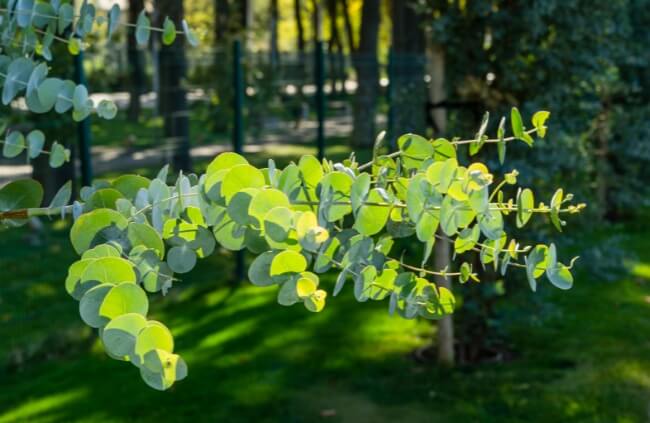
Mulching Eucalyptus gunnii
This plant like fertile soils, so mulching with garden compost in spring helps to boost macro nutrients like nitrogen and potassium, and maintains the soil health generally.
Avoid using rotted manure as a regular mulch for E. gunnii, as it can cause over-feeding as a result of the ammonia content (even when rotted). It also protects the shallow roots of this temperate native from any excessive summer heat, and locks in moisture for summer.
Eucalyptus gunnii Fertiliser
Similarly to mulching, or as a replacement to mulching, any general, balanced, slow release fertiliser such as chicken manure pellets, fish, blood & bone, or general purpose Osmocote granules, can all be used in spring to provide balanced feed throughout the year.
This is most effective for coppiced or young trees, and not necessary for healthy mature cider gums.
Water requirements
This plant needs watering through periods of drought while it establishes. Despite its love of clear, temperate, seasonal changes, including wet springs and cold winters, it does tend to cope quite well throughout Australia once mature.
Pruning Eucalyptus gunnii
As described earlier in the article, this plant doesn’t need pruning, but responds very well to it, with rapid regrowth of up to 1.5 to 2m a year.
Coppicing triggers the most vigorous growth as roots establish properly in the ground, offering energy for a mature tree, but only needing to feed fresh young growth.
If you decide to change a taller tree into coppice, or reshape a multi-stemmed cider gum, you can do that in early spring, which triggers new growth from near the cut point, usually developing vertically from a node near the top of the branch.
If you want to trigger new growth on a eucalyptus from a specific point, look for any swollen points along a branch, and make a small notch just above the swell. This will trigger growth from that point specifically, before cutting anything else off.
Repotting Eucalyptus gunnii
You shouldn’t have to repot Eucalyptus gunnii, as it is generally quite happy to be restricted, but once every two years, shake soil away from the roots, and consider pruning them lightly if they become pot bound.
Pair this with coppicing the top growth completely to reinvigorate that, and focus energy on foliage rather than roots.
Common Eucalyptus gunnii Pests and Diseases
Eucalyptus gunnii don’t tend to suffer many pest or disease problems, particularly in warmer parts of the country where they are even less likely to become waterlogged, unless planted on very unsuitable ground.
There aren’t many pests that feed on eucalyptus, a generally accepted pest-deterring species. But gall wasp, and eucalyptus suckers (psyllids) do cause problems.
Eucalyptus suckers
Eucalyptus suckers are true bugs that tend to stay on the same mature tree their entire life, and rarely move disease between trees. If you notice discoloration, remove the branch and wipe off any visible pests, but otherwise, they won’t cause lasting damage and can be allowed to exist.
Gall wasps
Gall wasps cause a lot of visual problems with Eucalyptus gunnii, but again, the damage is seasonal, and unless the wasps return the following year, your tree will recover to normal health.
Most fungal problems with Eucalyptus gunnii will go away by themselves without control, but some, including Anthracnose, and any form of root rot needs fast action.
Eucalyptus rust
Others, like Eucalyptus rust, are non-native fungal diseases and pose a threat to Australia’s native trees. Signs include small pustules that start out pale, before becoming yellow, and eventually coating entire leaves.
It is distinct in its focus on young leaves in particular and will cause defoliation. Affected leaves, and fallen leaves should be gathered and burned to slow down the spread of disease.
Eucalyptus gunnii Frequently Asked Questions
Do you need to prune Eucalyptus gunnii?
If you’re growing Eucalyptus gunnii at home, it almost definitely requires pruning, as it can reach well over 30m tall. Coppicing is the easiest pruning method, of growing your eucalyptus as a multi stemmed tree can limit its eventual height.
Is Eucalyptus gunnii suitable for a small garden?
Eucalyptus gunnii is suitable for small gardens, provided it is regularly coppiced or grown with alternately pruned stems to maintain a set height. Otherwise it will very quickly outgrow its space.
Does Eucalyptus gunnii have invasive roots?
Eucalyptus tree roots are not strictly invasive, and should not damage property, but they are shallow, and widespread, so can lift flags, and draw a lot of moisture from other parts of the garden.
Can I top my Eucalyptus gunnii?
You shouldn’t top a Eucalyptus gunnii, just as you shouldn’t top any tree. Topping is simply removing the top height of a tree, with no consideration for form, or strength, and creates more weak growth high in the canopy, which is dangerous to anyone below, and the tree itself.
Does Eucalyptus gunnii need ericaceous soil?
Eucalyptus gunnii does not need ericaceous soil, but it will be perfectly fine if that’s all you have. They are tolerant of most soil pH conditions, so any organic compost with good drainage (which most ericaceous mixes are) will do nicely.
Wrapping Up Our Eucalyptus gunnii Growing Guide
As one of the hardiest, toughest eucalyptus plants you can grow, Eucalyptus gunnii, the cider gum tree, strikes the perfect balance between garden design, and practical plant choices.
Provided you know how to grow Eucalyptus gunnii, and are prepared to treat it well, either with coppicing, or regular mulch while it establishes, you’ll have a long-lived and beautiful tree or shrub that will perfectly and pristinely stand out in your garden.
Published on October 3, 2023 by Nathan Schwartz
Last Updated on October 18, 2024


